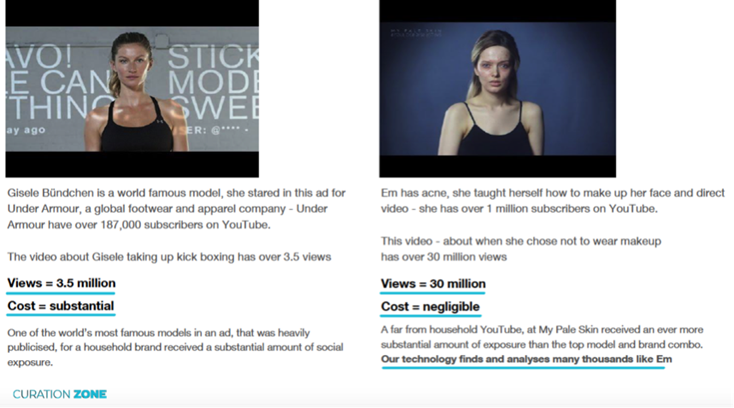Celebrity Endorsement Could Become a Thing of the Past – Replaced by online word-of-mouth influencers
Influencers have changed the way people connect, discover and share information, and brands are taking notice. Historically, advertisers turned to celebrities to endorse their products. Now they can use influencers to get their message straight through to the buyer.

It’s unlikely that anyone who identifies as a ‘influencer’ today will remember where TV advertising began. It was in 1955 and featured a tube of Unilever SR toothpaste. Since then little changed in the way that advertisers get through to the public. Catchy, funny, memorable ads with big name celebrities. But in the last five years, it’s changed more than it has in the last 70.
To understand the change it’s useful to have a little advertising history lesson. The “soap opera” is only named because in the ads they sold soap. Companies selling such staples were the early sponsors of 1930s radio and as such the name stuck - unlike the grease the products were developed to remove.
Fast forward to the 50s, which were often referred to as the “dream decade”. Mad Men were popping up everywhere and modern, interruptive advertising - the TV ad - was developed by and for their benefit.
TV became the platform that advertising was built for and as such programing evolved to make advertising work – short form, with lots of ad break potential. Colour TV helped cement this success and throughout the 70s, 80s, 90s, nothing much changed.
Then came the Internet, followed by YouTube, user generated content, other social media platforms and smartphones. Before anyone had a chance to realise, the rules of the game suddenly changed.
Perhaps the drastic extent to which things have changed can be exemplified by a story that PJ Pereira, Co-Founder of Pereira O’Dell, a leading advertising agency, tells in The Art of Branded Entertainment about a recent family stay in a holiday home that had no Internet.
He sat his young daughter in front of the TV, put on the cartoons and left her to it. A short while later she came crying to him: “Daddy where has my cartoon gone?”. It had been interrupted by adverts. Being used to streaming and on-demand services, she had never witnessed such an event, something as brazen as an advertising break.
Like PJ Pereira and many others, I believe that instead of interrupting the entertainment we enjoy, advertising should nestle neatly in with our consumption of whatever it is we watch. Just add a byline stating which brand had sponsored or commissioned the content and as long as it makes sense – in other words is appropriate and has a meaningful link to the brands culture - consumers won’t see it as an interruption – as annoying.
Another way in which the advertising world is shifting is their approach to using celebrities, who were once accepted as the gold-standard for brands.
Let’s look at two examples: My Pale Skin is a YouTube channel with over one million subscribers. It’s focused on make-up tips for people with problem skin – especially women – run by YouTube influencer and campaigner Em Ford.
She posted a video called You Look Disgusting, challenging social media trolls by showing the comments she got when she showed her face without make up. It received over 30 million views.
Compare this with an Under Armour video that featured the world famous model and actor Gisele Bündchen, called I Will What I Want, which also challenged her trolls. She got 3.5 million views.
The difference? One is a celebrity and the other is a relatable, i.e. ‘real’ person. In the former example Em Ford made the video herself on a very low budget. Brands are starting to sit up and take notice of the genuine and the authentic.
There is no doubt that in some areas celebrity holds cache in advertising. For example, fashion is a hotbed for endorsement or “designed by” fashion lines. Rihanna just launched a luxury range for LVMH marking the first time that the conglomerate has launched a brand from inception since Christian Lacroix in 1987.
But even in that niche, advertisers cannot ignore how the digital world is changing our relationship with marketing and the people that market to us.
The prevalence of Instagram and YouTube means unlikely people become celebrities. They have become effective channels to promote talent that has been overlooked (or arguably underserved) by traditional TV advertising models. What YouTube and similar platforms have done is allow viewers to access niches. And when you look at certain niches on a global level, they no longer look so small.
By using influencers, advertisers can bypass the interruptive advertising model, and get their message straight through to the buyer. Brands can now promote to specific demographics, which TV has always been very poor at. Influencers can appeal to a micro niche, and Curation Zone’s technology is designed to help brands find them. Could you imagine a series on TV of ‘unboxing’ – where people unbox the latest goods? Of course not. But that is often watched by many millions on YouTube because the ‘influencer’ is well known for their ‘unboxing’ skills.
Social Media has changed the way people connect, discover and share information in every possible way. Social media marketing has in effect gone right back to the old word-of-mouth method, only it’s powered by data and sophisticated technology so those word of mouth recommendations can be steered right where an advertiser wants them to go.